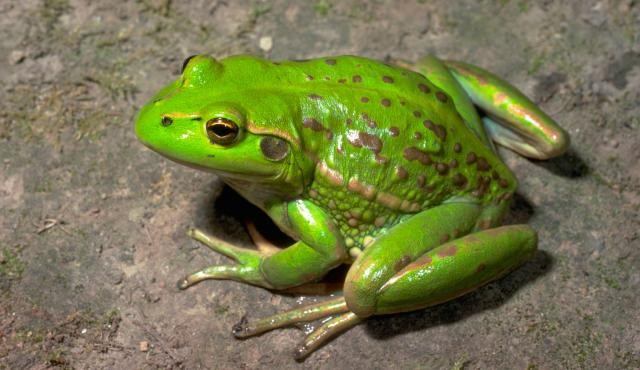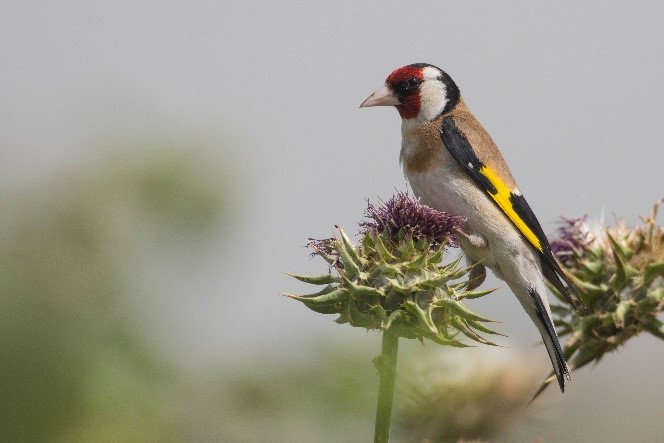Sanctuary Lakes is renowned for its magnificent water feature, the Lake. The estate also has seven ponds, each one different and equally fascinating. This month I would like to look at the smallest and without doubt the least conspicuous of our ponds and yet one of our most interesting. It lies almost in the geographical centre of the Estate. North of the Driving Range and Pinnacle, south of Times Square and Jubilee or if you are a golfer on the convergence of the 11th and 13th Green and the 12th and 14th Tee. This small pond, which for convenience I will name the Seventh Pond, is a recycled water pond, created as a storage and drainage facility for the Course. Thanks to, Dylan’s golf course maintenance team, who over the past twelve months have cleaned up the area making it attractive to two remarkable neighbours. One a native who is verging on the national endangered list 'The Growling Grass Frog' and the other, a hundred and fifty-year migrant 'The European Goldfinch.'
 Growling Grass Frog (Litoria raniformis)
Growling Grass Frog (Litoria raniformis)
Last month I was taking an early morning walk in the Seventh Pond's vicinity when I heard a loud distinctive call of the Growling Grass Frog's mass choir. Each individual call being a growl of about one second duration "crawark-crawark-crok-crok" rising and then falling in tone, often described as the sound of a duck being strangled. Looking down into the pond and casually floating in open water were a dozen or so males calling to their mates.
The Growling Grass Frog is a large, ground-dwelling frog of up to 10 cm from snout to vent. It is a mottled bright green and bronze colour above, often with dark brown enamelled bumps. It has a pale cream underside, with a faint cobbling pattern. A pale stripe runs from the side of the head down the flanks as a skin fold. The thighs are blue-green in colour.
Grass Frogs are active in the warmer months of the year (September to March) and like to bask in the sun on mild, sunny days. Like most frogs they usually call, feed and move around after dusk or early morning.
Breeding begins in August when calling males start to attract females, although females usually don’t begin to lay eggs until October or November. Males will continue calling until about the end of March but females don’t usually respond unless the season is very wet and warm. Eggs are laid in spring so the frogs need water that lasts over the summer for their tadpoles to develop. Females lay up to 4,000 eggs in foamy jelly rafts which sink into submerged vegetation within twelve hours. The hatching of tadpoles depends on water temperature, with 18 to 24 degrees Celsius being optimal. It may take up to five days in lower temperature conditions.
The tadpoles hide in aquatic vegetation or move to deeper water if disturbed. The tadpole stage generally lasts several months and they may grow to 110 mm in total length. In Victoria, most tadpoles have emerged as frogs by the end of May.
The Growling Grass Frog is believed to be in decline across much of South East Australia. In some regions, it has disappeared altogether, but locally here on the fringe of the Great Basalt Plain they are becoming abundant again. Thanks in part to the types of natural creeks, waterholes and created waterbodies, like the Seventh Pond, all ably supporting healthy Growling Grass Frog populations.
Standing by the banks and watching the frogs enjoying the early morning sunshine when I noticed patches of Scottish Thistle near the pond and there a pair of birds with ‘made for the job’ beaks were eating their favourite morsels the thistle's drying seeds. They were of course the magnificent European Goldfinch.
 European Goldfinch (Carduelis carduelis)
European Goldfinch (Carduelis carduelis)
The brightly coloured and extremely attractive European Goldfinch was first released in Melbourne over a hundred and fifty years ago, and initially they populated rapidly, where traditional food plants such as scotch thistles and other exotic weeds were available, but changes in farming practice and greater use of herbicide have limited the population in many areas.
The Goldfinch is a lightweight, small bird (about 13 centimetres). Adults have a distinctive red face with black and white surrounds; the crown is black extending into crescents down the sides of the head; a white band runs from ear to ear under the chin. Lores (between beak and eyes) are black. The beak is bone-coloured with a black tip.
The body is mostly shades of brown, under parts are white with buff-brown wash; tail is black with white tip. Wings are black with a golden yellow mid-bar and white tips on flight feathers. Eye brown, feet buff. Adult males and females similar, males have a slightly larger red area on the face than females.
The Goldfinch live in small flocks with pairing taking place in late August and breeding between September and March. The nest is located within bushes several metres above the ground and built entirely by the female using mosses and lichens and lined with plant down such as that from thistles. The clutch is typically 4-6 eggs which are whitish with reddish-brown speckles. Several pairs may nest in the same bush and share a communal feeding range. After hatching the young will make their first flight within 12 to 15 days. The parents typically raise two broods each year and occasionally three.
In Medieval times European Goldfinches were commonly kept in captivity because of their distinctive appearance and pleasant song. They also regularly appeared in the Arts, Music and Literature of that period.
Because of the thistle seeds it eats, in Christian symbolism the Goldfinch is associated with Christ's Passion and his crown of thorn. The Goldfinch appears in Renaissance paintings of the Madonna and Christ child, representing the foreknowledge Jesus and Mary had of the Crucifixion. Raphael in 1505–6 painted the masterpiece Madonna of the Goldfinch.
In music Vivaldi composed a Concerto in D major "Il Gardellino" where the singing of the Goldfinch is imitated by a flute.
My favourite example is from the English writer Chaucer in his 14th century 'Cook’s Tale'.
"Gaillard he was as goldfynch in the shawe" (translated into modern Australian - Gaily dressed he was as is a goldfinch in the woods).
Sitting by the pond's banks watching the Frogs and Goldfinches I began reflecting on my time as a young boy when I would fill a jam jar with frog spawn (eggs) and then spend three months enjoyably watching the Frog's life cycle and encouraging the spawn to tadpoles, then tadpoles slowly growing into full size Frogs. But there again I am told we have progressed, young lads have the Tablet now.